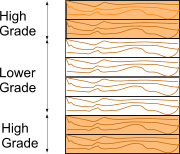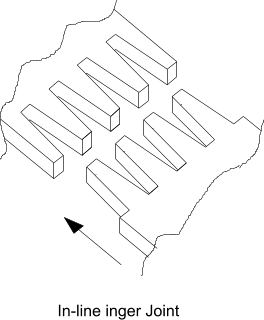Timber Index Page
Glued Laminated Timber
|
Introduction Glued laminated timber is often called Glulam and is manufactured as timber laminations
bonded together using adhesive. Glulam can be made to almost
any size and used for a wide variety of structural features including arches, portals, roof, lintel and floor beams,
for columns, rafters and 'A' frames etc etc Glulam structural members can
make use of smaller and less desirable dimensions of timber, yet are engineered to be stronger than similarly
sized members made of solid wood. They also suffer less than solid timbers from defects and movement
due to moisture changes such as checking, warping and twisting. The laminations used
are also generally of a more uniform quality compared to solid timber sections. Relevant Standards..For comprehensive list of standards Wood related Standards
BS EN 14080:2005 Timber structures. Glued laminated timber. Requirements Horizontally glued laminates This type of laminate is designed to resist loads normal to the plane of the laminates. The grades stress for horizontally glued timber laminations is obtained as the product of the
relevent stresses found in tables and the relevant modification factors found in the table. Modification factors for horizontally glued single grade laminates
The above rule cover only applies when laminations of one strength grade only used. It is acceptable to use laminations of different grades when the grades are up to two grades apart and when a maximum of 25% of the depth at the top and bottom of the section are of the superior grade. When timbers of different grades are use the calculated grades stresses relevant to bending tension and compression, parallel to the grain, should be multiplied by 0,95. The calculated grade stress for shear parallel to the grain should be multiplied by 0,8
Summerising the derivation of the relevant permissible stresses for the glued laminate sections..
Bending parallel to grain Vertically glued laminates This type of laminate is designed to resist loads parallel to the plane of the laminates. The grades stress for horizontally glued timber laminations is obtained as the product of the
relevent stresses found in tables and the relevant modification factors found in the table. Modification factors for vertically glued single grade laminates
Summerising the derivation of the relevant permissible stresses for the glued laminate sections..
Bending parallel to grain Glued end joints relevant to glued laminated timber According to BS 5268-2, finger joints, used to produce longer gluded laminated beam lengths from shorter lengths, should have characteristic bending strengths of not less than the characteristic bending
strength of the strength class for the lamination when tested in accordance with
BS EN 385.
|
- moelven..Supplier website with lots of useful information
- Glulsmbeams co.uk/Specificationsb....Supplier website with lots of useful information
- Wood Handbook -- Wood as an Engineering Material..Downloads ..Comprehensive Document (American ) Excellent
Timber Index Page


